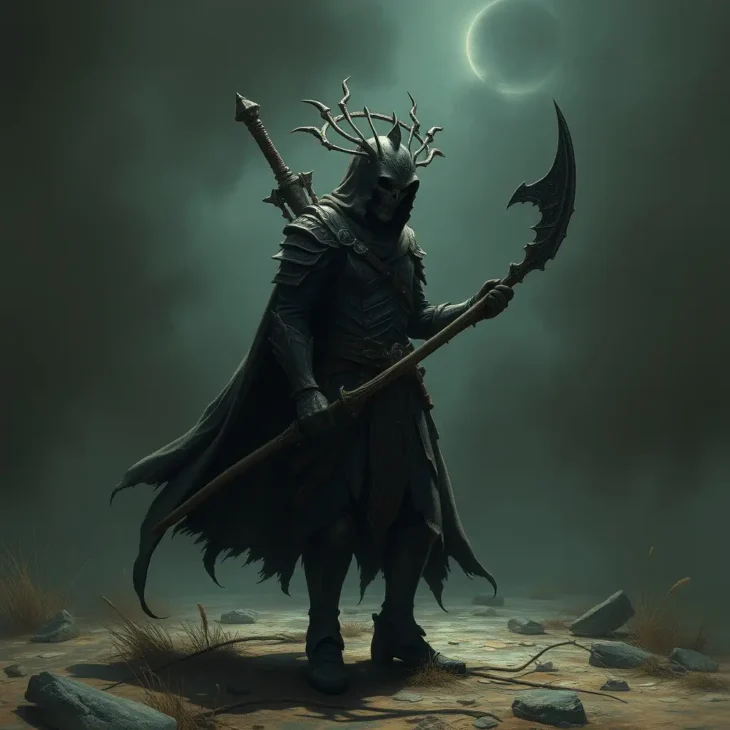Onryo: Japan’s Grudge-Bearing Ghosts | Ancient Spirits

I’ll never forget the first time I heard about Japan’s onryo. These vengeful spirits are filled with anger and a desire for revenge. They have been a part of Japanese folklore for centuries, influencing literature, art, and culture.
My journey into the world of onryo began in Kyoto. I was exploring a historic temple when I saw a ghostly figure carved into a monument. The temple priest told me a haunting story of betrayal and sorrow. It was about a spirit’s unending quest for vengeance.
After that, I was hooked on the stories of onryo. These spirits are a big part of Japan’s supernatural world. Their tales show the deep emotions and mysteries of the afterlife. They remind us of the power of grief, resentment, and the connections we have with the past.
Key Takeaways
- Onryo are vengeful spirits in Japanese folklore, fueled by intense resentment and a thirst for retribution.
- These ancient supernatural entities have captivated the imagination of the Japanese people for centuries, leaving an indelible mark on their literature, art, and cultural psyche.
- The stories of onryo are steeped in the complexities of human emotion and the mysteries of the afterlife, reflecting the enduring power of grief, resentment, and the unbreakable bonds that tie us to the past.
- Onryo are not merely figments of imagination, but rather reflections of the human condition and the darker aspects of the human experience.
- Understanding the significance of onryo in Japanese culture provides a unique glimpse into the rich tapestry of the country’s supernatural beliefs and traditions.
Understanding the Origins of Japanese Ghost Folklore
To truly appreciate the world of Onryo ghosts, we must explore Japanese folklore and its spiritual roots. These vengeful spirits are deeply connected to Japan’s cultural traditions. These traditions have shaped Japan for centuries.
Early Shinto and Buddhist Influences
The Onryo ghost comes from Shinto and Buddhist beliefs. Shinto sees the natural world as full of spiritual energy, with beings called kami. Buddhism brought the idea of _gaki_, tormented spirits. Together, they created the Onryo, spirits seeking revenge.
Evolution of Spirit Beliefs in Japanese Culture
As Japanese culture grew, the Onryo legend became a big part of it. Stories, history, and literature told of these ghosts. Each story added to the Onryo’s legend, showing Japan’s fears and worries.
Historical Documentation of Ghost Stories
Onryo ghosts are well-documented in Japanese history. Stories like the _Heike Monogatari_ and the _Nihon Ryōiki_ tell of their wrath. These tales show the Onryo’s lasting impact on Japan.
What Makes Onryo Different from Other Spirits
Onryo, the vengeful spirits of Japanese folklore, are unique. They are driven by a strong need for revenge. Unlike many ghosts, they don’t just linger or scare. They aim to right wrongs or avenge their deaths.
Onryo are known for their power and determination. They can change the physical world, making their presence known. They cause disasters and harm to scare and punish.
“The Onryo’s wrath knows no bounds, for they are fueled by a bitter resentment that extends beyond the grave.”
Onryo don’t just haunt; they actively seek revenge. This focus on vengeance sets them apart from other ghosts. They have a clear goal, unlike ghosts with varied motivations.
The Onryo’s story often begins with a tragic or untimely death. Anger, despair, or betrayal fuels their spirit. This mix of emotions powers their haunting, making them some of the most feared spirits in Japanese lore.
The Cultural Impact of Onryo: Japan’s Grudge-Bearing Ghosts
The Onryo, Japan’s legendary grudge-bearing ghosts, have deeply influenced the country’s culture. These vengeful spirits have made a lasting impact on Japanese literature, entertainment, and even religious and social practices. Their influence shows how these ancient legends continue to captivate us.
Influence on Japanese Literature
For centuries, the Onryo have inspired Japanese writers. They’ve been featured in everything from classic ghost stories to modern thrillers. Their tales delve into human emotions, the effects of unresolved conflicts, and the connection between the living and the dead.
Impact on Modern Entertainment
The Onryo have also left their mark on Japan’s entertainment world. They’ve starred in chilling films and eerie video games. These vengeful ghosts continue to thrill and scare audiences, making a lasting impression on Japanese pop culture.
Religious and Social Significance
The Onryo’s influence goes beyond entertainment and literature. They’ve shaped Japan’s religious and social norms. These spirits remind us of the need for harmony and respect between the living and the dead.
The Onryo, Japan’s grudge-bearing ghosts, have become a part of the nation’s culture. They’ve influenced literature, entertainment, and even religious and social practices. Their legacy continues to inspire and captivate, showing the power of storytelling and the mysteries of the supernatural.
Famous Historical Cases of Onryo Hauntings
Japan’s folklore is filled with scary tales of onryo, vengeful spirits. These haunting revenge stories have fascinated people for centuries. Some have left a big mark on Japanese society. Let’s look at a few famous onryo hauntings.
Lady Rokujō from “The Tale of Genji” is a well-known case. She was scorned by her lover and her vengeful spirit haunted her rival. This story has been told in many ways, from books to movies, making the onryo’s legend live on.
Oiwa, a woman from 18th-century Japan, was murdered by her husband. Her vengeful spirit haunted her killer, driving him mad. He eventually died. This story is famous in Japanese horror, seen in “Yotsuya Kaidan.”
These stories have captivated the Japanese public for generations. The onryo hauntings show the deep cultural impact of these vengeful spirits. They continue to influence Japan’s art, literature, and culture.
Physical Manifestations and Common Characteristics
Onryo ghosts from Japanese folklore are quite unsettling. They are vengeful spirits with deep grudges. Their supernatural traits make them stand out.
Visual Appearance
Onryo are usually female figures with long, dark hair. Their sunken eyes give off an eerie, soulless look. They wear long, tattered white robes, symbolizing their tragic fate and unresolved issues.
Behavioral Patterns
Onryo ghosts seek vengeance with a single-minded focus. They are known for their blood-curdling wails. These cries can be heard at night, striking fear in those who hear them.
They can appear and disappear suddenly. This makes them seem to come out of nowhere to confront their targets. Then, they vanish just as quickly.
Environmental Effects
The presence of an Onryo ghost can change the environment. The air may get colder, and lights flicker. The atmosphere becomes heavy with dread.
In some cases, objects move or levitate. It’s as if the spirit is controlling them. These strange happenings add to the Onryo’s unsettling nature.
The Onryo ghost is a part of Japan’s ghost folklore. It shows the lasting impact of Japanese curses and unresolved grudges. Their appearance and behavior remind us of the dangers of deep-seated resentment and the supernatural forces it can unleash.
Rituals and Methods for Appeasing Vengeful Spirits
In Japan, people face vengeful spirits and curses with ancient rituals. These practices come from Shinto and Buddhist traditions. They aim to calm the wrath of Onryo, the ghosts that haunt us.
The Obon festival is a yearly event where families honor their ancestors. They light lanterns to guide spirits and offer food and flowers. This is believed to calm Onryo and stop their revenge.
“The Obon festival is a time-honored tradition that allows us to pay our respects to our ancestors and appease the spirits that linger among us.”
People also use talismans and amulets to keep evil spirits away. These objects, with Shinto or Buddhist symbols, protect homes and individuals.
For severe cases, a Shinto priest or Buddhist monk performs an exorcism. They chant, burn incense, and use holy water. Their goal is to remove the vengeful spirit and bring peace.
Modern Interpretations of Onryo in Japanese Media
The stories of Onryo, Japan’s vengeful ghosts, have long fascinated people everywhere. Recently, these spirits have made a comeback in modern Japanese media. They appear in films, books, and video games.
Film Adaptations
Hollywood has shown a big interest in Onryo with hits like “The Ring” and “The Grudge.” These movies have brought these scary ghosts to life for viewers around the world. They’ve helped shape how people see Japanese ghost stories.
Literary References
Onryo have also become a big part of Japanese literature. Authors have included these vengeful spirits in their stories. The Onryo Curse, a highly praised book, explores the deep psychological and cultural sides of these ghosts. It has drawn readers from all over.
Video Game Representations
Video games have also been influenced by Onryo. Japanese game makers have added these ghosts to their games. Games like “Fatal Frame” and “Project Zero” take players into the spooky worlds of Onryo. They mix reality with the supernatural.
The Onryo continue to captivate audiences in Japanese media. Their stories of revenge and the supernatural keep drawing people in. They show the lasting appeal of these haunting tales.
Prevention and Protection Against Onryo Curses
Exploring Japanese folklore can be scary, especially with the onryo spirits. But, there are old and new ways to keep them away. These methods can protect you from Japanese curses.
Talismans and amulets are key to fighting off onryo. These objects, with their special symbols, can keep vengeful spirits at bay. The ofuda and omamori are favorites among the Japanese for their protective power.
“The power of these talismans lies not just in their physical form, but in the deep-rooted beliefs and rituals that imbue them with spiritual potency.”
Today, Japan also uses new ways to fight onryo. This includes special devices and onmyoji who do cleansing rituals. These methods keep the fight against vengeful spirits alive.
To stay safe from onryo, you need to know about Japanese culture and beliefs. Using both old and new protection methods helps. This way, you can live safely, knowing the vengeful spirits of Japan’s stories are just that.
The Psychology Behind Onryo Legends
Exploring the world of Onryo, Japan’s vengeful spirits, reveals deep social commentary. These ghost stories, rooted in centuries of tradition, offer a glimpse into Japan’s complex society. They highlight the struggles and injustices that have long been part of the nation.
Social Commentary Aspects
The Onryo legend is more than just a ghost story. It reflects Japan’s deep-seated societal issues. These spirits, driven by vengeance, often represent the marginalized and oppressed. Their haunting presence symbolizes the unresolved injustices and unhealed wounds in Japanese culture.
Gender Roles in Ghost Stories
The Onryo legend also uncovers Japan’s complex gender dynamics. Many iconic Onryo are female, symbolizing women’s historical struggles and oppression. These stories serve as a commentary on societal barriers and double standards faced by women in Japan. By empowering these female spirits, the Onryo legend challenges patriarchal norms.





